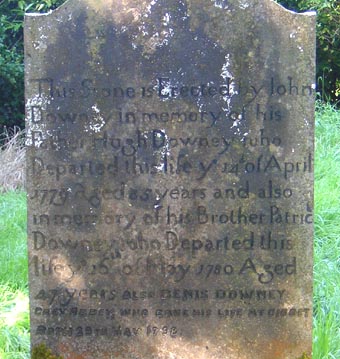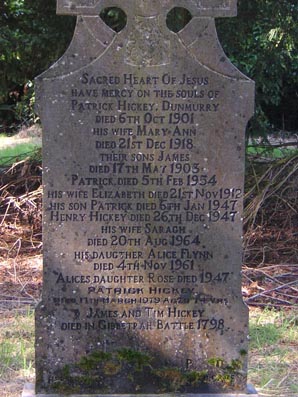« AN TOSTAL SOUVENIR PROGRAMME 1953 - CHAPTER 16 | Main | AN TOSTAL SOUVENIR PROGRAMME 1953 - CHAPTER 18 »
May 14, 2006
AN TOSTAL SOUVENIR PROGRAMME 1953 - CHAPTER 17
Chapter 17 of the An Tostal Programme 1953 is dedicated to the Massacre at the Gibbet Rath in May 1798. I have included two photographs of related gravestones in Dunmurry Graveyard. This graveyard was recently cleaned up by the Grey Abbey Conservation project.GIBBET RATH
IN the 1798 insurrection the United Irishmen of the two baronies of Uibh Failghe in Co. Kildare had risen. General Dundas had withdrawn his regular army and militia from the Kildare men’s area into Kilcullen. Kildare was occupied by the insurgents under Captain Garry of Kildare on the evening of the 24th May. On the 25th May, Captain Padraig O’Beirne of Nurney had led the men of Kildoon, Kildangan, Nurney and Riverstown in an attack on the Monasterevan Yeomen Garrison. Rathangan was taken on 26th May by a force under John Doorly of Lullymore, but on 28th May they were driven out by a combined force of British horse, foot and artillery. The general position in Kildare was one of stalemate. The King’s troops occupied large camps or fortified towns while the United Irishmen held the country. But Dublin had failed to rise and the men of Carlow had suffered a disastrous defeat on 25th May. General Dundas had offered favourable terms, including the raising of free quarters, and an amnesty for all insurgents who would lay down arms. These terms had been accepted by the Kilcullen men. General Dundas, accompanied only by two dragoons, had gone to Knockaulen and accepted the arms from the insurgents. On the morning of 29th May, General Sir James Duff arrived from Limerick and was marching on Kildare with reinforcements, 250 militia infantry, two six pounder guns and 70 of Lord Roden’s Fencible Cavalry. On his way he had collected about 200 of the South Cork Militia Regiment with their two battalion guns. [, - sic] about 50 of the Fourth Dragoon Guards, and some of the Monasterevan Yeomanry of both Bagot’s and Hoysted’s corps. One Cooper of Ballymanny acted as intermediary and advised the people of Kildare to proceed to the Rath of the Curragh, saying that he himself would undertake to persuade General Duff to take their surrender there. The Kildare people did so. Duff commanded the rebels, as he called them, to throw their arms in a heap. He then ordered the troops to charge and spare no rebel. The cutting down of the unarmed men was too easily accomplished. The number of Kildare men who were massacred was 325. In one street alone of Kildare town, 85 widows were counted the following morning—Fr. Hurley, S.J. Lecture in Kildare, Leinster Leader 17/6/1950.
In a plot about 25ft by 40ft. enclosed by a 3ft. wall in Kildangan graveyard there is a slab 1ft. 9in. x 3ft. at each end. On one is inscribed “the burial ground of Stephen Rice, Cherrymills, 1795,” and on the other “the burial place of John Hoysted, Walterstown, 1795.” There is also a flat broken stone inscribed “This monument is in memory of John Hoisted, Esq., Walterstown, who died 28 March 1848.” The plot is called “Hoysted’s barn.” A few yards away adjoining Father Hanigan’s grave in the same graveyard is a stone inscribed:“here lies the body of Thomas Murphy who departed this life May 29, 1798, aged 49 years. Also the body of Patrick Murphy who departed May 29, 1798, aged 45 years. Erected by their wives Bridget and Madge.” Near the Boland plot is an old tombstone inscribed: Erected by James Gilmor in memory of Michael Gilmor who departed this life June 7, 1798, aged 30 years. R.I.P.”
[Two baronies of Uibh Failghe are the two Baronies East and West Offaly or Ophaely; free-quarters – soldiers were billeted on the local populace at the expense of the local populace; Knockaulen read Knockaulin or Dun Alinne ]
The Grey Abbey Conservation Project have recently cleaned up Dunmurry Cemetery. Our thanks to Frank, Paddy and Christy for their brilliant work. There are two graves in Dunmurry which had information added about family members who lost their lives at the Gibbet Rath - Denis Downey of Grey Abbey whose story was retold by Fr. Swayne in his book Kildare in '98 and also Tim and James Hickey. I took these photos on 18 September 2005.


Chapter 17 of the An Tostal Programme 1953 is dedicated to the Massacre at the Gibbet Rath in May 1798. I have included two photographs of related gravestones in Dunmurry Graveyard. This graveyard was recently cleaned up by the Grey Abbey Conservation project.
Posted by mariocorrigan at May 14, 2006 03:27 PM